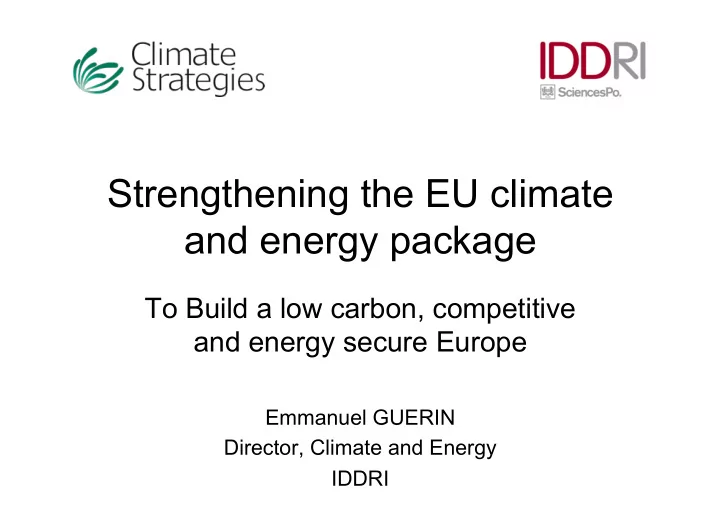

Strengthening the EU climate and energy package To Build a low carbon, competitive and energy secure Europe Emmanuel GUERIN Director, Climate and Energy IDDRI
Scope of the report / presentation • 2 questions: – Why strengthen the CEP? – Why strengthen it now? • 3 answers: – Reach the LT climate target at acceptable costs – Enhance competitiveness – Increase energy security • 3 policy recommendations: – Implement energy efficiency plan targeting existing building and transport infrastructures to reach 20% target – Increase stringency and enhance predictability of the EU ETS up to 2030 – Use auction revenues and EU budget to facilitate transition towards a low carbon economy
Reach the LT climate target at acceptable costs • EU politically committed to reach at least 80% emissions reduction by 2050 • Reaching only 20% emissions reduction by 2020 leads to declining GDP during the last decade to reach the 80% 2050 target • Moving to 25% by 2020 (plus 5% offsets, 30% overall) increases significantly the GDP trend in the last decade, at a marginal GDP cost during the first two decades.
Reach the LT climate target acceptable costs GDP Mean annual growth rate 2 1,5 1 20% by 2020 0,5 30% by 2020 0 Source: CIRED -0,5 2010-2020 2020-2030 2030-2040 2040-2050
Reach the LT climate target acceptable costs • 2 key explanations: – Tackle inertia in sectors with long lived capital stocks and characterized by market failures and regulatory barriers (building and transport infrastructures) – Shape expectations and provide RD&D support for low carbon products and services innovation
Enhance competitiveness • Firms producing energy efficient and low carbon products – Low Carbon and Environmental Goods and Services (LCEGS): market already worth close to 3,5 trillion euros a year – Growing faster than most of other sectors (4% a year for next 5 years) – EU has the highest share of global environmental patents , – But growth has been higher in Japan during the past 10 years – Korea and China, have higher specialization in environmental patenting.
Enhance competitiveness Growth 1990 - 2005 (%) Share (%) of world of world environmental patent environmental patents by type Source: Bruegel
Enhance competitiveness • Sectors at risk of carbon leakage – Scope of potential carbon leakage is narrow , impacts on competitiveness are small on average – But, despite free allocation , some industries might be significantly impacted by an increase of the 2020 emissions reduction target (cement, steel, aluminum…). – Current approach of free allocation is not a sustainable strategy for decarbonising carbon-intensive industry – Review of leakage risks will take place in 2014: this will be the time to adopt more sustainable strategies, taking into account: • Comparability of mitigation efforts by 2014 • Dynamics of global actions
Enhance competitiveness • For the economy as a whole – High carbon competitiveness is a contradiction in terms in the long run – In a world of unequal global carbon prices, enhancing competitiveness through climate policies is a balancing act between: • Short / long term • Market pull / technology push instruments • Economically optimal / politically feasible
Increase energy security • A strengthening of the CEP focusing on reducing energy demand through targeted action on building and transport infrastructures would: – Reduce dependence on gas and oil imports – Especially in the transport sector • 30% emissions reductions by 2020: oil consumption in the transport sector reduced by 59.5 Mtoe compared to BAU • Gross savings of approximately 35 billion Euros per year up to 2020.
Increase energy security Source: Ecofys
Increase energy security – Facilitate the transition towards a low carbon power sector • Reduction of final energy demand Lower quantity of final energy to be electrified • Reduction of gas used for heating More gas can be used for power generation
Policy recommendations • Implement energy efficiency plan targeting existing building and transport infrastructures to reach 20% target – Existing building stock ( deep retrofit ) – Transport infrastructures ( modal shift ) • Increase stringency and enhance predictability of the EU ETS up to 2030 – Take into account increased action on energy efficiency – Reassess carbon leakage risks • Use auction revenues and EU budget to facilitate transition towards a low carbon economy, in particular in CEE MS
Conclusions • To reach these three objectives – Time consistency – Competitiveness – Energy security • Increasing EU short term emissions reductions targets is necessary, but not sufficient . It needs to: – Be inscribed in a consistent emissions reduction pathway 2050 roadmap (panel 2) – Target the key areas , esp infrastructures in the building and transport sectors energy efficiency plan (panel 3) – Come with the appropriate complementary policies , esp public support RD&D multi annual financial framework (panel 3)
Participants to the project • The Center for International Research on Environment and Development ( CIRED ), on the time consistency of the EU emissions reduction pathway, and the the competitiveness and leakage impact of moving to 30% by 2020 • E3G , on the global race towards low carbon technology competitiveness • ECN , on the low carbon technology innovation and diffusion implications of moving to 30% • ECOFYS , on the consistency on the EU emission reduction, renewable energy and energy efficiency targets , and on the energy security impacts of moving to 30% • The International Consulting on Energy ( ICE ) on the employment impact of climate policies • IDDRI on the investment dynamics in the electricity sector • The Finish institute of International Affairs ( FIIA ) on the energy security impacts of moving to 30% for Poland, Czech Republic and Latvia , and on the use of the EU budget to support the transition towards a low carbon economy in Central and eastern European (CEE) countries
Recommend
More recommend